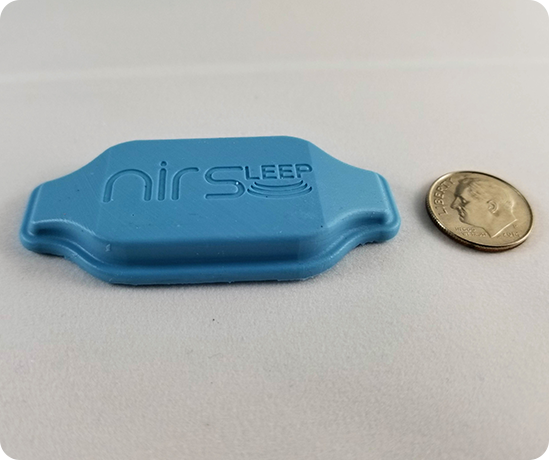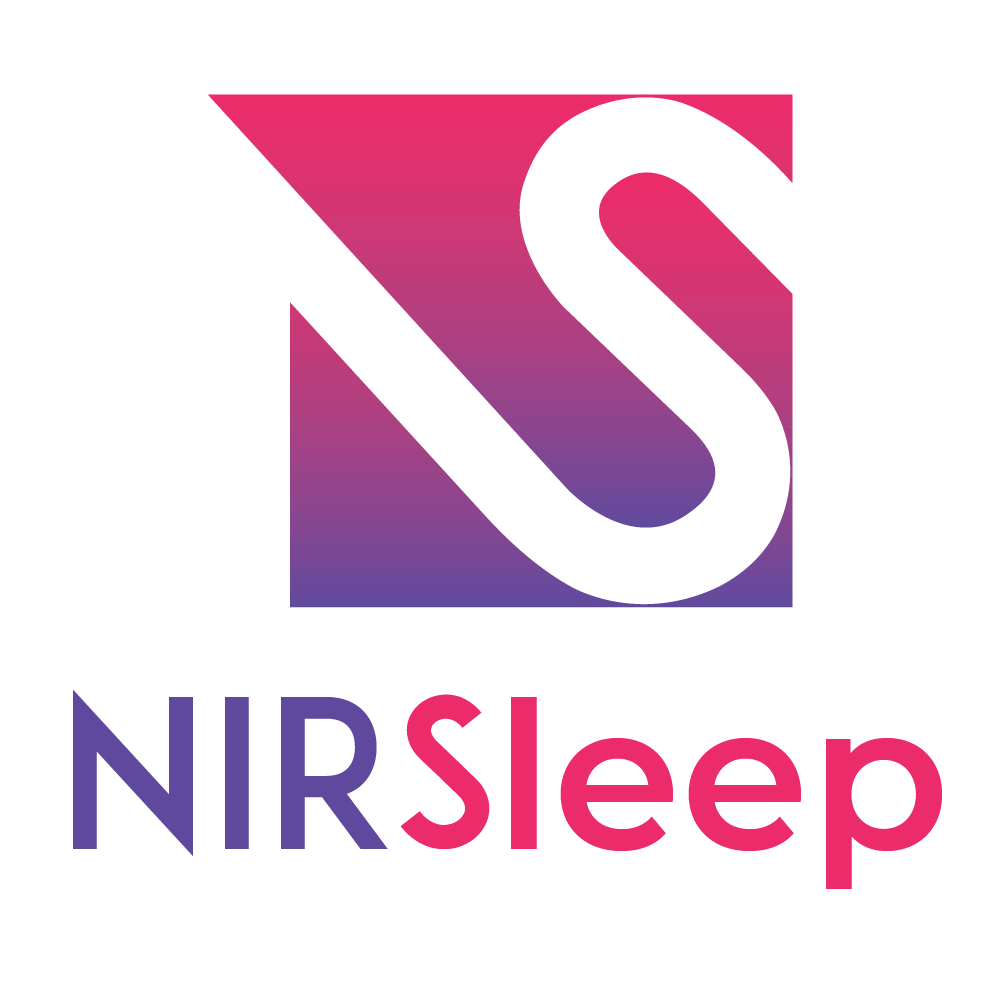
Technology
ENLIGHTENED SLEEP SENSINGFor better sleep measurement

The general trend towards remote patient monitoring is flourishing in the sleep field, and devices that can objectively measure sleep with high ecological validity are highly desired by practicing clinicians. NIRSleep is developing a small wearable noninvasive brain imaging system to serve this need, and to support remote populations by increasing the accessibility, availability, and acceptability of critical sleep medicine. The device will enable accurate remote sleep monitoring in the comfort and privacy of user’s homes by creating virtual sleep labs for the preliminary screening of OSA and other common sleep-related disorders such as insomnia and depression.
The NIRSleep remote sleep monitor generates objective, consistent data in a wearable, non-invasive package. The device is fully encapsulated in silicone and both communicates and charges wirelessly, resulting in highly robust packaging tolerant of immersion in liquid environments, vibration during transport, dust, and moderate impact (i.e. intrusion protection level 68). NIRSleep uses fNIRS, a mature technology, to measure sleep problems directly at the source – the brain – by measuring cerebral oxygenation (ScO2). When the brain is active (e.g. during REM sleep), it consumes more oxygen; when the brain is less active (e.g. during deep sleep), it consumes less oxygen. NIRSleep also utilizes an inertial measurement unit (IMU) which has multiple accelerometers to determine head position during apneic events (when a user temporarily stops breathing while asleep). The low size, weight, and power (SWaP) package sticks unobtrusively to the user’s forehead and optically measures oxygen consumption in the brain’s frontal lobe. The platform is lightweight and can operate as an independent patch or integrate into any headgear touching the forehead (such as a band, skull cap, or helmet). The specific sensor geometry and system engineering can enable deep measurement to determine cerebral oxygenation directly, unlike other devices which can only measure blood oxygenation in the skin and scalp.
The NIRSleep system is designed to calculate sleep indices such as sleep onset latency, wake after sleep onset, total sleep time, apnea/hypoxia index, and sleep efficiency. The NIRSleep platform delivers the combination of 1) greater clinical relevance over surface/peripheral oximetry available on commercial wearables with 2) less obtrusiveness and complexity than clinical polysomnography (PSG). Our clinical work on the NIRSleep platform has already demonstrated the ability to identify sleep behavior in subjects in supervised clinical settings.
The NIRSleep device is an inexpensive and ruggedized cerebral oximeter that can be deployed in uses cases and environments beyond the capability of large existing clinical tools and which can deliver more clinically-relevant measurements than consumer wearables. The data stored and streamed from the device may be sent directly to medical practitioners, providing continuous information for user monitoring or treatment optimization. The platform itself could be deployed to detect and predict a range of neurovascular and cardiovascular conditions affecting human performance, and the device packaging is robust and resistant to physical abuse encountered in the fielded environment as well as direct environmental insults such as dirt and water. The device charges inductively, communicates wirelessly, and stores data onboard before securely transferring it to our centralized cloud.
Technical Discussion
of fNIRS and NIRSleep

Functional Near Infrared Spectroscopy (fNIRS) is a well-established non-invasive technique to measure blood oxygen changes in the brain (cerebral hemodynamics). Despite the incredible insights that real-time brain oxygenation can enable, there are currently no small area wearable sensors available with such capability. The compact, lightweight, and low power combination of cerebral fNIRS and head motion (cranial actigraphy) that NIRSleep delivers is an exciting new tool for ambulatory neuroimaging.
Human tissue is translucent to near-infrared (NIR) light between 700nm and 900nm, while oxygenated and deoxygenated hemoglobin in our vasculature absorb light strongly at these wavelengths. Carefully selecting LEDs within or near these wavelengths allows for differentiation of their instantaneous relative absorptions. To determine concentration differences between these chromophores of hemoglobin in the brain, emission and detection systems (“optodes”) are placed ipsilaterally from one another on the skull to sense backscattered light. Concentrations of oxy- and deoxyhemoglobin can be extrapolated from this backscattered light using the modified Beer-Lambert Law (mBLL), which relates the concentration changes in these hemoglobin states to the optical wavelengths chosen and the path length of backscattered photons. The optode spacing determines light penetration depth, making geometry a critical design parameter for device performance.
The NIRSleep device performs continuous wave fNIRS based on hemoglobin’s absorption spectra. An optical detector multiplexes the backscattered light to determine the oxygenation state of the blood in the underlying tissue. NIRSleep also utilizes multiple accelerometers in an inertial measurement unit (IMU) to accurately detect head movement and posture. Through these sensors, the platform can extrapolate the user’s heart rate, respiratory rate, cerebral oxygenation, motion, and position.
NIRSleep’s exterior packaging physically isolates the device from interfering factors on the user’s body such as sweat, skin cells, moisturizers, etc. and isolates the device from dirt and water. When packaged, the unobtrusive form factor is less likely than existing home sleep test (HST) packages to disrupt the user or impact sleep onset, duration, or quality. Medical grade silicone encapsulates the device to ensure both chemical and optical isolation, while allowing for flexible packaging and conformal optical coupling on the forehead. Inductive charging allows the unit to be charged without the need for external wires and a corresponding point of ingress. A single button under the silicone turns the device on and off and onboard memory allows for both real-time Bluetooth streaming or data download via sync after use. The NIRSleep device can be applied to the forehead with a medical adhesive patch for close optical coupling or use with gear touching the forehead such as a headband, skull cap, or helmet. The optical system can sit on either side of the forehead at an offset from the cerebral fissure.


